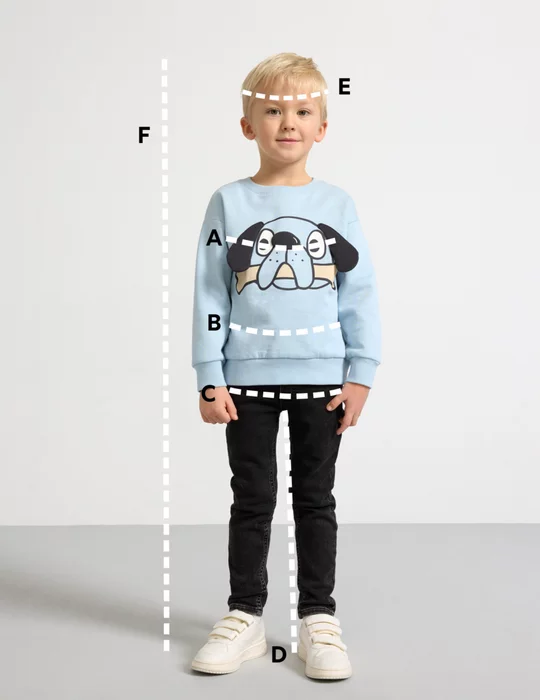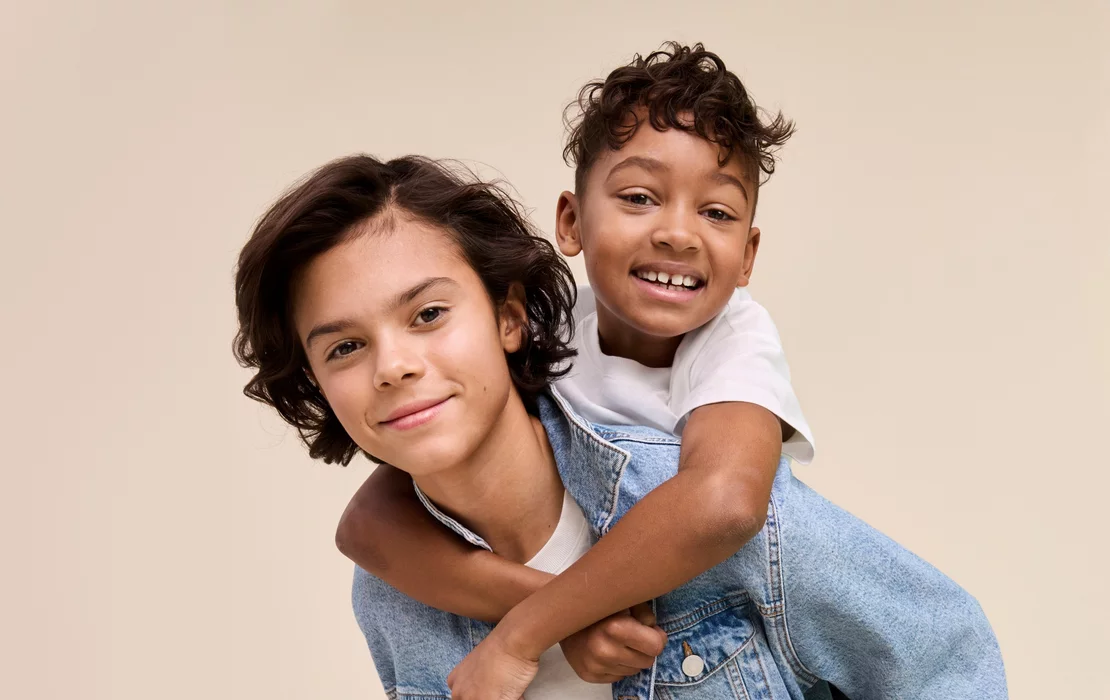Kids grow up fast. And while it may not be as fast as during those first 12 to 18 months, measuring them every 6 months is the best way to stay ahead of their growing curve.
2-8 years size chart
| 2-8 years size chart | ||||||
|---|---|---|---|---|---|---|
| Duble sizes | ||||||
| Age (in years) | ||||||
| Chest | ||||||
| Waist | ||||||
| Hips | ||||||
| Inner leg length | ||||||
| 92 | 98 | 104 | 110 | 116 | 122 | 128 |
| – | 98/104 | 110/116 | 122/128 | |||
| 1,5-2 | 2-3 | 3-4 | 4-5 | 5-6 | 6-7 | 7-8 |
| 52 | 54 | 56 | 58 | 60 | 63 | 65/66 |
| 51 | 52,5 | 54 | 55 | 56 | 57 | 58/59 |
| 57 | 60 | 60 | 62 | 64 | 66 | 68/69 |
| 38 | 41,5 | 45 | 48,5 | 52 | 55,5 | 59 |
Boys 7-14 years size chart
| Size | |||||||
|---|---|---|---|---|---|---|---|
| Duble sizes | |||||||
| Age (in years) | |||||||
| Chest | |||||||
| Waist | |||||||
| Hips | |||||||
| Inner leg length | |||||||
| 128 | 134 | 140 | 146 | 152 | 158 | 164 | 170 |
| – | 134/140 | 146/152 | 158/164 | – | |||
| 7-8 | 8-9 | 9-10 | 10-11 | 11-12 | 12-13 | 13-14+ | |
| 65 | 68 | 71 | 74 | 78 | 82 | 86 | 89 |
| 59 | 61 | 63 | 65 | 67 | 70 | 73 | 76 |
| 68 | 71 | 74 | 77 | 81 | 85 | 89 | 92 |
| 59 | 62 | 65 | 68 | 71 | 74 | 76,5 | 79 |
Boys 7-14 years size chart - wider fit
| Size | |||||||
|---|---|---|---|---|---|---|---|
| Age (in years) | |||||||
| Waist | |||||||
| Hips | |||||||
| Inner leg length | |||||||
| 128 | 134 | 140 | 146 | 152 | 158 | 164 | 170 |
| 7-8 | 8-9 | 9-10 | 10-11 | 11-12 | 12-13 | 13-14+ | |
| 63 | 65 | 67 | 69 | 71 | 74 | 77 | 80 |
| 75 | 78 | 81 | 84 | 88 | 92 | 96 | 99 |
| 59 | 62 | 65 | 68 | 71 | 74 | 76,5 | 79 |
Girls 7-14 years size chart
| Size | |||||||
|---|---|---|---|---|---|---|---|
| Duble sizes | |||||||
| Age (in years) | |||||||
| Chest | |||||||
| Waist | |||||||
| Hips | |||||||
| Inner leg length | |||||||
| 128 | 134 | 140 | 146 | 152 | 158 | 164 | 170 |
| – | 134/140 | 146/152 | 158/164 | – | |||
| 7-8 | 8-9 | 9-10 | 10-11 | 11-12 | 12-13 | 13-14+ | |
| 66 | 69 | 72 | 75 | 78 | 81 | 83 | 85 |
| 58 | 60 | 62 | 64 | 66 | 67 | 68 | 69 |
| 69 | 73 | 77 | 80 | 83 | 86 | 88 | 90 |
| 59 | 62,5 | 65,5 | 68,5 | 71,5 | 74,5 | 77,5 | 80,5 |
Girls 7-14 years size chart - wider fit
| Size | |||||||
|---|---|---|---|---|---|---|---|
| Age (in years) | |||||||
| Waist | |||||||
| Hips | |||||||
| Inner leg length | |||||||
| 128 | 134 | 140 | 146 | 152 | 158 | 164 | 170 |
| 7-8 | 8-9 | 9-10 | 10-11 | 11-12 | 12-13 | 13-14+ | |
| 62 | 64 | 66 | 68 | 70 | 71 | 72 | 73 |
| 75 | 79 | 83 | 86 | 89 | 92 | 94 | 96 |
| 59 | 62,5 | 65,5 | 68,5 | 71,5 | 74,5 | 77,5 | 80,5 |
Kids hat sizes
| Head circumference in cm | ||
|---|---|---|
| Size / age | ||
| About 50-52 cm | about 52-54 cm | about 54-57 cm |
| 2-4 | 5-7 | 8-13 |
Kids sock & slipper size
| Age (in years) | ||||||||||||
|---|---|---|---|---|---|---|---|---|---|---|---|---|
| Sock & slipper size | ||||||||||||
| 1,5-2 | 2-3 | 3-4 | 4-5 | 5-6 | 6-7 | 7-8 | 8-9 | 9-10 | 10-11 | 11-12 | 12-13 | 13-14+ |
| 22-24 | 25-27 | 28-30 | 31-33 | 34-36 | 37-39 | 40-42 | ||||||
Kids shoe sizes
| Age (in years) | ||||||||||||
|---|---|---|---|---|---|---|---|---|---|---|---|---|
| Shoe size | ||||||||||||
| 1,5-2 | 2-3 | 3-4 | 4-5 | 5-6 | 6-7 | 7-8 | 8-9 | 9-10 | 10-11 | 11-12 | 12-13 | 13-14+ |
| 22-24 | 25-27 | 28-30 | 31-33 | 34-36 | 37-39 | 40-42 | ||||||

How to measure your child.
Measure the head’s circumference with a tape measure, just above the eyebrows, to get the the most accurate hat size.

So, we compiled a few things to think about for each age and included a handy size chart for kids clothes, plus an easy-to-use measuring guide for kids aged between 2 and 14 years. These will help you understand your kids size, as well as guide you on how to match their measurements with the right size clothes.
The basics for each age and stage:
Small kids: 2-8 years
Between ages 2 and 4, kids are active and curious about the world around them; their development is absolutely booming. Their days are filled with play, which means they may need to change clothes more than once or twice a day. During the colder months when they are outside playing, protective layers are no guarantee for keeping the moisture out, so stock up on extra socks and waterproof accessories.
When buying outerwear, consider sizing up, so you don’t find yourself needing to buy another set of jackets and overalls in the middle of the season. Use the handy kids size chart below, to determine which size fits your kid the best and if between two sizes, size up!
Between ages 5 and 8, think comfort: sweatpants and leggings tend to be favourites for pre-school and school kids. Perhaps they have started to develop their own sense of style and want to be included in buying new clothes, which can also be a fun activity for both of you.
Tip: opt for good quality clothes with seasonless design, which can be passed down to a younger sibling in the future.
Bigger kids: 8-14 years
As kids grow older, they might also want to be involved in the process of purchasing clothes. Some preteens and teens not only want garments that look and feel great, but also that fit their sense of self and identity.
For kids between ages 8 and 14, stock up on comfortable basics, such as t-shirt, hoodies and sweatpants. These are the perfect pieces for wearing at home or hanging out with their friends. Look for good quality clothing with breathable fabrics, that will easily keep your kid feeling comfy throughout an active day outside or inside.
Prepare them for all seasons by adding layers to their wardrobe. Fleece sweaters and long-sleeved tops can be a saviour during any time of the year. And since they are now old enough to walk to school by themselves, make sure you buy outerwear and accessories with reflective details, which will keep them safer on the road.